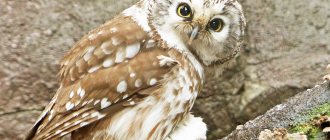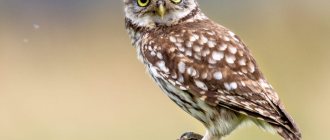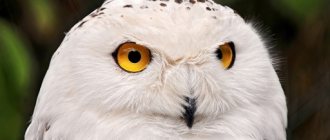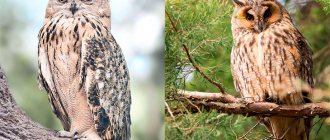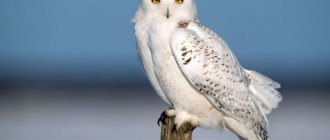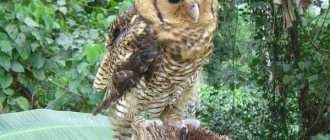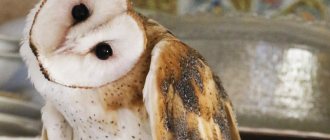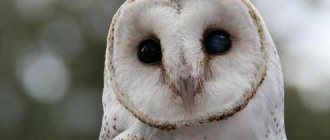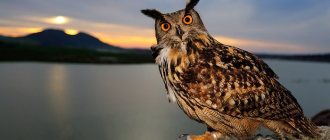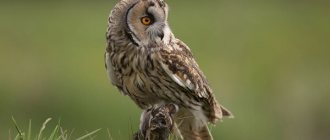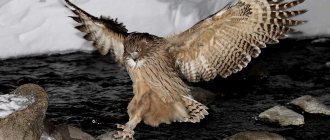Genus of owls. What is the difference between an owl and an owl?
Before deciding how an owl, an eagle owl and an owl differ, let’s find out what each of them is, study their external characteristics, habits, lifestyle and behavioral characteristics.
They are all unusual nocturnal birds. In addition, they are predators and look completely different from their other feathered relatives.
So, let's find out how an owl differs from an eagle owl and an owl.
Declension of the noun owl (which case)
Declension of words by case in singular and plural.
| Case | Question | Unit | Mn. number |
| Nominative | (who what?) | owl | owls |
| Genitive | (who, what?) | owls | owls |
| Dative | (to whom; to what?) | owl | owls |
| Accusative | (who, what?) | owl | owls |
| Instrumental | (by whom, what?) | owl | owls |
| Prepositional | (About who about what?) | owl | owls |
Scope of use
Biology Zoology Colloquialism Medicine Forestry
Owl: description of external characteristics
The most distinctive feature that makes an owl stand out is its large muzzle and head with large round eyes. The owl's beak is curved, short, with nostrils located at its very base.
The owl's plumage is thick and soft, its wings are round and large, and its tail is rectangular. In addition, the wings of those birds that hunt in the forest are short, while those that prefer more open areas (and fly more often) have long wings. But they are still large compared to their body weight, which allows birds to fly, easily gliding, silently and without much effort.
The feathers of owls living in forests are usually brownish in color. And owls living in deserts are lighter in color (reddish).
Females differ from males in their larger sizes, but the color of their feathers is almost the same. Only the polar owl has males with snow-white plumage, while females have feathers with noticeable brownish specks.
Let's look at the difference between an owl and an eagle owl below.
Owls from the genus of owls
Owls are relatively small owls with a larger build. They have no feathered ears. The bird has a clearly defined facial disc of black color with a white frame.
Under the beak they have a black spot, reminiscent of a beard, framed by white, horizontally elongated spots. The ridges between the eyes are light gray, eyebrow-shaped (crescent-shaped), located from the beak towards the inside of the facial disc. The pupils are black, the iris is yellow. The eyes are small, the beak is yellow.
Among them, occasionally (eastern populations) there are completely black birds, in which bright yellow eyes are clearly visible on the facial disc.
Females here are larger than males and are indistinguishable in color.
The owl differs from the eagle owl in its brighter and more saturated gray color, a bright, clearly defined facial disc with many cone circles, the absence of “ears,” medium-sized yellow eyes, and a darker color.
What does an owl bird look like?
The appearance of this owl resembles the chick of larger representatives of owls. The owl's head is flattened and oval, the facial disc is very weakly expressed. ... Owls have expressive yellow eyes. Outwardly, the owl looks very gloomy and, at first glance, aggressive.
Interesting materials:
How to add dye to mastic? How to add music to Instagram story 2022? How to add music to an Instagram post? How to add music to Instagram Stories? How to add a new contact on WhatsApp on your computer? How to add a pirate to steam 2022? How to add dust to a photo in Photoshop? How to add a site to Kaspersky's whitelist? How to add a site to Kaspersky Free exceptions? How to add a scanner to a MacBook?
Beautiful bird eagle owl. How does an eagle owl differ from an owl in appearance?
The eagle owl is an unusually attractive bird. This is a larger owl, with a wingspan of which their length reaches from 150 to 170 centimeters, and the length of each wing is up to 50 centimeters. Its weight is about 2 kg.
Its eyes are reddish-yellow, its beak is dark, one might say black. On the sides of his head there are tufts of feathers that form something like ears (nothing in common with real ears). Both females and males have the same coloration.
What is a male owl called?
Owls are overwhelmingly nocturnal. They are not migratory; they roam over a relatively small area in search of food.
Usually, most people would like to immediately call a male owl an eagle owl, but this is still not correct. An owl is an owl, and an eagle owl is an eagle owl, without adjustment for gender.
Just like, for example, owls, owls, barn owls, and tawny owls. These are all owls, but the species are different.
Therefore, there is nothing else left to do but simply call it a male owl and a female owl. Unfortunately, this is the case with owls (as with many other birds and animals). “Owl” is like a universal name.
However, some people jokingly call the male owl, and the female, owl. This is not at all scientific, but it is clear and understandable)
Often in the animal world, the female and the male have their own names. She-bear, she-wolf, hare-hare. But this doesn't always happen.
Sometimes it is mistakenly believed that owls are females, and males are eagle owls.
The owl and the eagle owl belong to the same owl family, but they are different birds.
It is not clear why, but the owl was made a symbol of wisdom. “What, Where, When” chose it as a symbol of transmission and the highest sign.
The owl is a nocturnal bird of prey. There are long-eared owls and gray owls. These are owls. Eagle owls are larger than owls. They weigh 3-4 kilograms.
Both the male and female owls are called the same owl. The same thing happens with eagle owls and the male is called an eagle owl. If you need to clarify, add a male owl.
In the Russian language, it often happens that representatives of the animal world have some kind of common name, but there is no gender division in the name. And if there is a cat and a cat, then a mouse always remains a mouse, regardless of its gender.
The situation is similar with owls: an owl, regardless of its gender, will still be called only an owl and nothing else. In order to distinguish a boy owl from a girl owl, you will have to use an additional word indicating the gender of the bird, which is usually placed before the word “owl”: female owl or male owl.
A male owl is not at all an eagle owl as one might think, since an eagle owl is a completely different bird from the owl family and its female is also called an eagle owl. Therefore, in nature there are only male owls and female owls, and therefore both of them should be called owls.
According to the biological classification, pigs belong to artiodactyls, a subspecies of wild boar; this animal has been domesticated by humans for several centuries.
Their genetic code is very close to humans.
There are many breeds of pigs, the biggest division being fat and meat breeds.
A male pig is called: boar, boar, hog.
In pig farming, they prefer to castrate the boar for meat, then the hormones testosterone and skatole are no longer produced in the male’s body and the specific smell when cooking pork disappears. A castrated male is called a hog. It was on the hog that Margarita’s maid Natasha rode in Bulgakov’s novel “The Master and Margarita.”
Partridges belong to the group of Galliformes. They are not large in size. There are many different subspecies. And only the northern ones turn white in winter. The southern subspecies remains the same colorful in winter.
During the mating season and hatching of the young, the male partridge, unlike all other species of this group, acts like a true family man. he forms a pair with a female and even during incubation of eggs sometimes replaces the female, and also participates in feeding the offspring.
Sexual demorphism of male partridges is represented by a larger size, in contrast to females, and brighter inclusions in the plumage.
In our region there is a subspecies shown in the photo - gray partridge.
The male duck is most often called a “drake.” When we had ducks, the male was called that. It is larger in size and has more colorful plumage than the female.
In different areas there are other names for drakes; they are called selekh and kachur.
Source
What is the difference between an owl and an eagle owl: photo
The common eagle owl is a species of bird of prey from the order Owls. Owl and eagle owl are different species.
Each of the birds of the owl order has its own characteristics.
What is the difference between an owl and an eagle owl? Firstly, owls are more numerous than eagle owls.
1. The owl is much smaller than the eagle owl, and it does not have feathered ears like the first one (except for the long-eared owl species).
2. Most owls have a frame of short, hard feathers on the front of their heads, which is absent in the eagle owl.
3. Owls fly very silently and glide easily, and the wings of an eagle owl produce audible whistling sounds during flight.
4. An owl, as a rule, hunts smaller animals, and an owl’s prey can be a large hare or even a young roe deer.
Lifestyle
Owls are nocturnal predators. While the eagle owl tracks prey at any time of the day. His diet is more varied. Due to its impressive size, the bird can hunt large prey, such as:
- hare;
- muskrat;
- nutria;
- fox;
- roe;
- raccoon dog;
- otter;
- baby goats, wild boar, sheep, deer.
Sometimes an eagle owl's prey exceeds its size by 10 times. The predator also hunts inconvenient prey - hedgehogs, turtles, lizards, snakes. Thanks to its pointed beak and tenacious claws, the bird can easily cope with any defense of its prey.
The diet of owls is dominated by smaller prey: rodents, small and medium-sized birds, frogs, insects. Also, the menu of all owls, including the eagle owl, includes plant foods - grass, fruits, berries, leaves.
Interesting! The eagle owl's diet consists of 100 species of mammals and 300 species of birds. None of the other birds of prey can boast of such a variety of menus.
There are similarities in the reproduction of owls and eagle owls - all representatives of owls form one pair during their lives. Marital behavior is somewhat different. As for owls, only the male makes the mating call, and the female only responds to his advances. During the mating ritual of eagle owls, both partners talk. Also during courtship, touching with wings, beaks, and mutual bowing are noted.
An eagle owl's clutch consists of 3-4 eggs, sometimes their number reaches 6. Other types of owls lay up to 10 eggs, and incubation lasts about 10 days less (3-4 weeks). Eagle owl chicks often eat their younger brothers. Among other owls, a similar phenomenon also occurs, but much less frequently.
A clutch of a fish (Far Eastern) eagle owl does not contain more than 2 eggs. This is due to dietary habits. The predator's diet consists mainly of fish. In the conditions of the Far East, it is quite difficult to feed a large number of hatched chicks. Especially in winter, when the water in the rivers freezes.
If there is potential danger (for example, a predator near the clutch), the eagle owl circles over the nest, wings spread wide. In this way the bird shows its power to the enemy.
Habitats
The eagle owl is the most widespread species of owl.
How does an owl differ from an eagle owl in terms of habitat?
The eagle owl is a bird that can adapt to the most diverse and unpredictable living conditions. It can be found in the Ussuri region in dense forests, and in the polar forests on the Mezen, and in Altai in the mountain taiga, and in the Ukrainian steppes, and in the deserts of Mongolia.
It can also live in the Tien Shan mountains, the eastern Pamirs and Tibet (even at an altitude of up to 4,000 m above sea level). The eagle owl takes root well in any place and tolerates any weather conditions.
Owls also live in territories almost all over the world, from the very equator to the harsh cold northern territories. You can find them everywhere: on the shores of the seas, in the mountains, in deserts, in the steppes. Most of this species of birds lives in forests (and wooded areas).
Not many of them (for example, the short-eared owl) prefer larger open areas. And some of the owls, unlike eagle owls, willingly settle in populated areas under the roofs and in the attics of houses. You can also see them in park areas of cities. This is another point in how an owl differs from an eagle owl.
It is important to note about eagle owls that people sometimes use them as a bird of prey, but there is one drawback to this - this bird is difficult to train. The Eagle Owl is a rarity. Moreover, there are often extremely dangerous attacks by birds on their owners if they are not kept and raised properly.
Description of the owl
Due to the fact that these birds have some differences in body structure, they had to be classified as a separate, independent species.
The skeletal structure of owls has several important features. For example:
- All main bones have characteristic processes.
- The lower jaw has 3 points of articulation with the skull.
- The third finger is significantly smaller.
- The outer fingers are capable of bending backwards.
- A significant part of the species has a characteristic notch, which is located on the back of the sternum.
As you know, these predators can easily turn their heads 270 degrees. This is possible due to the formed expansion of the carotid arteries closer to the level of the lower jaw. The result is an increased number of smaller blood vessels connected to larger arteries. These arteries are connected to each other using special anastomotic bridges, which does not allow the vessels to critically compress.
Appearance
Owls are distinguished by the fact that they have a peculiar facial disc, consisting of 5 rows of hard and expanded feathers, forming a radiate corolla. The flight feathers are characterized by the presence of rounded ends, as well as a bend towards the body. Some species have fringes or sawtooth tips on the outer webs of the first three feathers. Thanks to this structural feature, owls can fly completely silently. The third and fourth feathers are slightly longer. The tail feathers are located on a relatively short tail and also have a characteristic bend, but only downward. The owl's legs are almost completely covered with small but dense feathers.
Interesting to know! Almost all species of owls belonging to the order “Owls” are distinguished by a relatively dull color of their body, although these shades are combined with the environment, especially in dark conditions.
Owls have sharp and long claws, which are characterized by a curve, like the beak of this bird. The beak ends with a kind of small hook, with the help of which the owl makes peculiar sounds similar to clicking. The owl's wax is short and covered with bristly feathers. Regardless of the species, the owl is distinguished by the presence of fairly large eyes looking forward. This indicates that the eye sockets are located on the front of the skull. It is believed that owls are color blind and see the world around them in black and white gradations.
The owl also sees well during the day, although many believe that this is not the case. In fact, the eyes of this predator are not particularly sensitive to daylight. The owl's pupil contracts and dilates not only under fluctuating light conditions, but also with each inhalation and exhalation. The owl has a uniquely sensitive hearing. Experts believe that it is better than that of “cats”. The outer ear is relatively large and is covered by a fold of skin with feathers.
Behavior and lifestyle
Even today, scientists do not know anything about whether owls can be considered migratory birds. Despite this, scientists know that these birds prefer to lead a sedentary lifestyle. In addition, if owls settle in, they do so only in pairs. As a rule, these predators show their main activity at night, and during the day they rest either in nests or comfortably perched on a branch of a tree.
A little history! Our ancestors avoided these birds, as meeting them was considered a bad signal. On this basis, which smacks of mysticism, a not very good relationship developed between man and owls: they tried in every possible way to expel them if they settled near a person.
Unlike ordinary owls, polar owls lead an active lifestyle almost around the clock, especially on polar days. These birds live in pairs all their lives, from the moment the family is formed. However, many believe that these birds do not have a period of pronounced courtship, which is typical for other bird species. But, most likely, this is not the case, since these birds lead a secretive lifestyle. Even the fact that experts do not know whether these birds are migratory or not says a lot.
How long do owls live?
Under natural conditions, owls can live from five to fifteen years. The lifespan of these birds depends on many factors, including their habitat. Eagle owls are considered true long-livers. An eagle owl living in Sweden lived for 24 years and 9 months, which was recorded as a world record.
Interesting facts - Owls
Characteristics of the appearance of an owl
The distinctive feature that distinguishes an owl is its fairly large muzzle and huge round eyes. Her pupils are black and her iris is yellow . The bird has a short, slightly curved beak. The nostrils are located almost at the very base of the nose.
It has thick plumage, very soft. The shape of its tail is rectangular, its wings are large and rounded.
- Birds that prefer hunting in forest areas have short wings.
- Mammals that prefer open terrain for frequent flights have rather long wings.
Relative to the body weight of the bird, their wings are quite large. This allows you to fly quickly and easily, planning completely silently and effortlessly.
How do birds differ in appearance?
Birds belong to the order Owls. But these types are completely different .
Each squad has its own distinctive characteristics. Only the long-eared owl is similar in appearance to the eagle owl. It is considered a smaller copy of it. Females, as a rule, have a protective plumage color, which allows the birds to blend in with the colors of the surrounding nature and remain unnoticed during the day during their rest.
Females and males living in the forest zone have a brown tint. Birds living in the desert are distinguished by their reddish coloration . Females differ from males in their larger size and weight. The plumage color of these birds is almost the same.
Only the snowy owl has a snow-white color in its plumage. In females, brownish spots can be seen on the feathers.
The eagle owl has a rather large head and plumage with typical characteristics. Its weight reaches 2 kg. In the area of the ear canals you can see feathers that form something like auricles.
How to name a male cuckoo: 7 animals whose names only a zoologist knows the truth about
The Russian language never tires of giving us problems. Sometimes confusion arises with the genders of nouns. Let's take the animal world. An elephant has an elephant, a cat has a cat, but what do you call a male cuckoo? Kukun? Cuckoo? Cuckoo? Let's figure it out together.
Cuckoo: cuckoo, cuckoo or cuckoo?
Usually the names of animals of different sexes are formed using suffixes. A goose lives with a goose, a bear with a she-bear, and a siskin with (who do you think?) a siskin. There are exceptions. Kangaroo and muskrat are the best: these words can have both masculine and feminine gender, depending on whether we are talking about a female or a male.
There are also colloquial names. They are characteristic of exotic animals. They will understand you if you say “crocodile” or “dolphin,” but there is a more common option (discussed below).
You can come up with many options for the “husband” of the cuckoo. But alas, all of them will be incorrect from the point of view of the Russian language. So don't make up words that don't exist. It is better to follow the example of biologists, who call many animals the same, adding the word “female” or “male”. This means that the papa cuckoo is just a male cuckoo.
Using the same scheme, you can designate any animal whose name you doubt: a male chimpanzee, a female crocodile, etc.
You can come up with many options for the “husband” of the cuckoo. But alas, all of them will be incorrect from the point of view of the Russian language. So don't make up words that don't exist. It is better to follow the example of biologists, who call many animals the same, adding the word “female” or “male”. This means that the papa cuckoo is just a male cuckoo.
Crow: raven or raven?
“What is incomprehensible here? Of course, a male crow is a raven!” - many will think... and they will be wrong. This is a very common misconception. In fact, a raven and a crow are different birds (albeit related), and the confusion occurred because their names are similar. Moreover, this is the case only in the Russian language. For example, in English a crow is “crow”, and a raven is “raven”.
Crows are large blue-black birds. They live alone, away from people, for example, in the forests.
Crows, on the contrary, live in flocks and are often found in cities. These are very smart birds. A captive crow can even be trained to repeat words like a parrot.
There is no special word for a male crow. Just as with the cuckoo, he should simply be called a male crow.
Horse: horse or stallion?
Mom is a horse, child is a foal, dad is a horse? But no! The word "horse" is the same as "horse". Only it is of Slavic origin, not Turkic. From the word “horse” the word “prince” was formed, which at first meant a person on a horse.
But a male horse is a stallion. Hence, in fact, the word “foal”. A castrated stallion is called a gelding.
Pig: pig or boar?
In the children's cartoon Peppa Pig, the father of the pig family is called Daddy Pig. This is how misconceptions are formed from childhood. Because a male pig is actually called a boar. This is a funny word derived from the sound these animals make. A castrated boar is called a hog.
Vixen: fox or fox?
For foxes, things are not so simple. Firstly, from a zoological point of view, it is correct to call a female a fox. Fox is a colloquial word. Remember, even Krylov’s famous fable is called “The Crow and the Fox.”
Also colloquially, a male fox is called a fox. But this is also wrong! The official zoological term is foxtail.
And even the names of their cubs have nuances. They are really fox cubs, as we are accustomed to from childhood, but they can also be called puppies, because foxes belong to the Canidae family.
Zebra: zebra or zebras?
A lot of options immediately come to mind. Zebra? Zebrun? Or maybe even a zebra? It is important to remember here that zebras are relatives of horses. This means that a zebra’s “husband” can be called a stallion, just like in domestic horses.
Roe deer: roe deer or roe deer?
This small and very cute deer with small antlers is actually a close relative of the domestic goat. Initially, it was called a roe, but over time the word was transformed.
From a biological perspective, a male roe deer is simply a male roe deer. But the Altaians have their own word for it - “kuran”. August in Altai is called the “month of the roe deer” - “kuran-ai”. It is at this time that males compete for the female's attention.
Female and male animals sometimes have non-obvious names. These questions can confuse not only a child, but also an adult. In colloquial speech, of course, invented words are allowed, but from the point of view of the Russian language everything is clear. And now you are unlikely to make a mistake.
Source
Features of hunting
Most owls begin hunting only after dark. But an eagle owl can get food for itself during the day without any problems. Its high visual acuity allows it to rise to considerable heights when searching for prey. Typically, its diet consists of pheasants, voles, wood grouse and partridges that live in sparse thickets, in open areas of the steppe and forest-steppe. With a large wingspan of the bird, these places are most favorable.
Some owls can live in populated areas under the roofs and in the attics of houses. They are often found in city parks. This also distinguishes them from eagle owls.
The eagle owl is a sedentary bird, but often makes local migrations in winter and autumn. It even flies into populated areas and big cities. It is during this period that it most often catches a person’s eye.
Interesting fact: people sometimes try to tame an eagle owl. But he is quite difficult to train . Sometimes even he can attack his owner. The long-eared owl lends itself well to training.
In addition, there is also a fish owl. This is the namesake of the ordinary. But they do not belong to the same group. It's easy to distinguish them. The Fish does not have a characteristic feature of many owls - a facial disc. He was left with shapeless tufts of feathers, vaguely similar to sideburns. In the common eagle owl, the disc is clearly defined and bordered by a stripe.
The main difference between an owl and an eagle owl is as follows:
- Owls are much more numerous in nature.
- The owl is smaller than the eagle owl in size and weight.
- The eagle owl does not have a frame of hard feathers on the front part.
- Owls fly completely silently, and the eagle owl makes a whistling sound when flying with its wings.
- The owl feeds on smaller animals than the eagle owl.
The eagle owl can exist well in a variety of conditions. It even lives in mountains and deserts. Easily takes root in any weather conditions.
Owls for the most part prefer to live in wooded areas . But some owls (short owl) prefer open and spacious habitats.
The eagle owl is a very rare bird. It is very difficult to see it in the natural environment. It is listed in the Red Book as an endangered species.
Eagle owl and owl: what's the difference
, Posted in Owl Comments No comments
Many people mistakenly believe that an eagle owl is a male owl. In fact, in the owl family, which contains more than two hundred species, these are two separate varieties. The diversity of eagle owls is represented by almost two dozen species, while there are much more owls. There are many similarities between them, since they are all owls, but there are also some significant differences. In order not to confuse these birds, you should remember the main characteristics that allow you to understand the difference between an eagle owl and an owl.
Dimensions
Body size is one of the first characteristics by which you can understand the difference between an eagle owl and an owl. Representatives of the former are almost always larger than the latter.
Most species of eagle owls are distinguished by significant body dimensions, which, as a rule, are characterized by a barrel-shaped shape. The largest fish owl with a majestic wingspan and a massive body belongs to this genus of owls.
Scarecrows are slightly inferior to him in size. Their body length is usually between 65-75 cm, although larger representatives are occasionally found.
Most owls are significantly smaller in size than eagle owls. The only exceptions are the polar owl and the great gray owl. The white owl even initially belonged to the genus of eagle owls precisely because of its impressive dimensions, but was later isolated as a separate species.
The great gray owl even exceeds the largest eagle owl in body weight, and is comparable in length to scarecrows. But the absence of feathered ears identifies it as an owl, and the characteristic concentric circles around the eyes and the spot under the beak make it possible to recognize it as a representative of the tawny owl family.
Feather ears
If you see an owl of medium size, doubt may creep in: is it not an eagle owl? The difference in this case is determined by the presence of characteristic feather “ears”. Large tufts of feathers above the eyes, giving the bird a particularly stern appearance, are characteristic of all species of eagle owls.
But there is one small caveat: such signs also occur in some owls. In particular, feathery “ears” are characteristic of the long-eared owl and a number of cutworms. It’s quite easy to draw the line between where the owl is and where the eagle owl is, if you remember the difference in size.
All long-eared owls are smaller in size than eagle owls. Owls, on the other hand, are among the smallest species of owls, for which they are often called “miniature eagle owls.” Therefore, it will not be difficult to draw mutually exclusive parallels of characteristics in order to understand the difference between these owls and eagle owls.
Plumage color
Most eagle owls are distinguished by a more variegated and spotted plumage color compared to owls. The latter are characterized by a uniform color of feathers.
Many eagle owls live in forest thickets, so more variegated colors give them the most camouflage appearance. Also, the difference between them and owls is the presence of clearly visible dark stripes on the head and upper back. In addition, eagle owls' paws are usually densely furred.
Facial disc
This is another important characteristic that allows you to understand the difference between an eagle owl and an owl. The facial disc is characteristic of most representatives of owls and barn owls.
It is most pronounced in barn owls - the most famous owls with a white face that has a heart-like appearance. In many other species of owls, the facial disc is more or less noticeable, while for eagle owls it is not characteristic at all.
Lifestyle
The significant difference between an owl and an eagle owl lies in the lifestyle of these birds. All owls are considered nocturnal predators. They usually hunt at night and rest during the day. The exception is the polar owl, which is due to the peculiarity of its habitat and the peculiar uniqueness of the species, which in general is significantly different from a number of its relatives.
Eagle owls also hunt at night. But the peculiarity of the vision of these birds allows them to hunt in search of prey even during daylight hours. Since they are the leaders in size in the owl family, their prey usually exceeds what most owls catch.
Eagle owls also destroy various rodents, but their prey can be not only rats, but also hares, and even larger animals - roe deer, goats, badgers. Eagle owls are also one of the few birds that can even hunt hedgehogs and consume these prickly animals as food. They do not disdain to hunt their owl relatives, who are distinguished by their smaller dimensions.
Habitats
Owls usually live in forests and open areas. Although eagle owls are considered typical forest birds, they are still less picky in terms of housing. They can settle in very different areas (in the mountains, in the desert), and build their nests not only in tree hollows, but also among rocks, on the ground.
Although these large birds are not afraid of people, they still prefer not to nest near cities. Some species of owls are not afraid to roost in the attics of residential buildings. Moreover, these birds are more widespread around the world than eagle owls, most of whose populations are concentrated in Eurasia and North America.
Flight Features
The difference between an eagle owl and an owl is also clearly visible in its flight characteristics. Eagle owls have sharp feather tips, while owls have rounded feathers. Due to this feature of the flight wings and their characteristic bend, representatives of the first species fly, emitting a characteristic whistle during rapid flight.
Owls glide almost silently also due to the presence of soft pubescence on their wings. This feature allows them to fly up to the target chosen as prey absolutely unnoticed.
Mating season
Almost all representatives of owls are monogamous. There is no particular difference between eagle owls and owls in this regard. But there are some differences in the mating “flirts” of these birds. Male owls usually make inviting calls (often hoots) to attract females.
Eagle owls organize “negotiations”: males and females alternately call out to each other. Among owls, such behavior during the mating season is characteristic only of long-eared owls. The mating “trills” of eagle owls are rougher compared to the sounds characteristic of owls. For example, scops owls can produce real melodic trills.
Female eagle owls incubate eggs a little longer than owls (30-35 days versus 20-30). The number of future offspring they have is usually also smaller. Some species of eagle owls lay no more than 1-2 eggs. They are unpretentious in choosing a place to breed their offspring, and can lay eggs in a hole right on the ground, without equipping it in any way.
Source
Long eared owl
Asio otus or long-eared owl is a small bird belonging to the owl family. This species is characterized by rather long feather tufts on the sides of the head; they look like small ears. Owls of this breed have a uniform color. Long-eared owls live in forests, small copses and city parks. Birds of this species are migratory birds; they fly in groups of 10 or more individuals. Long-eared owls are quite difficult to meet, since owls do not fly during the daytime and are nocturnal. They differ from other owls not only in their feathered “ears” but also in their character and elements of behavior.
Origin of the species and description
Photo: Long-eared owl
Long-eared owl Asio otus. Owl order. Genus of long-eared owls. Species Long-eared owl. Owls have quite ancient origins. At the beginning of the Cenozoic era in the Eocene, these birds already inhabited the ancient forests of America, as evidenced by the ancient fossils of these birds found by scientists. Many extinct birds belonged to modern genera. The barn owl lived during the Miocene period, eagle owls have been known since the late Eocene.
Video: Long-eared owl
Ancient owls were very different from modern birds; they were not predators, and had behavioral differences. Over many years of evolution, birds of this species have developed their own specific style of hunting. Owls do not chase their prey, as other birds do, but lie in wait for their prey and quickly attack it. Today, owls are a well-separated group of birds in all respects. Systematically, owls are related to nightjars, rickshaws and parrots.
The species Asio otus was first described by the Swedish naturalist and scientist Carl Linnaeus in 1758. This species has some features that distinguish long-eared owls from other representatives of this species. Long-eared owls have a pronounced facial disc; rather high feather tufts, which are called “Ears,” are noticeable on the bird’s head. Owls of this species have narrow and stiff feathers and a beautiful “marbled” color.
Appearance and features
Photo: Long-eared owl bird
Males and females of this species do not have any special external differences. The bird's head is large and round in shape. The iris of the eyes is yellow or orange. The bird's facial disc is edged with dark feathers. The owl has hard dark feathers around its beak and light feathers around the chin. On the forehead between the feather fluffs there are marble-colored feathers.
There are several rows of black feathers around the eyes. The ear tufts consist of three or five brown feathers; on the outside the feathers have a reddish tint. On the neck and back the plumage is red, with brown spots. The spots do not merge into one pattern. About 4 black stripes are visible on the lower part of the bird's body. The flight feathers have 4 brown spots on the feathers and on the inside.
Young birds have the same color as adults, only their feathers are softer. A brown spot stands out 7-10 centimeters from the fold of the wing. The wingspan of an adult owl is 87-100 cm. The bird reaches 32-40 cm in length. In this species of birds, males are approximately 1–5% smaller than females. Externally, birds of different sexes are not very different.
Birds' wings are long and rounded. From behind, when the bird sits, the feathers overlap each other a little. The tail of owls of this species is quite long, rounded and consists of 12 tail feathers. The claws and beak are brown. The beak is sharp, rounded. The soles of the feet are grey. Long-eared owls live quite a long time; under normal conditions, an owl can live up to 25 years.
Interesting fact: An owl changes several outfits during its life. The plumage of down gives way to mesoptile, and by the second year of life permanent plumage begins to form. Owls moult annually.
Types of owls
This order includes only two families, represented by real owls and barn owls.
Subfamily True owls (Striginae)
- The genus “Owls”, which includes up to 5 dozen species, the main differences of which are large feathery “ears”, an incomplete facial disc, bare or with harsh bristles fingers. These birds are characterized by a reddish, brownish or grayish body color with speckles.
- The genus "Megascops", which includes up to 25 species of birds of prey.
- The genus "Tawny Owl", which includes 21 species, with a body length from 30 to 70 centimeters. This genus is distinguished by the fact that it does not have feather “ears”, while the facial disc is clearly pronounced. The birds have loose plumage, with a grayish or reddish color, with the inclusion of brown streaks.
- The genus “Eagle owls”, represented by 19 species. They lead a nocturnal lifestyle and are distinguished by a reddish-brown color with noticeable streaks. Eagle owls have clearly visible feather “ears” located on both sides of the head. Eagle owls, depending on the species, can have a body length from 35 to 75 centimeters.
- The genus "Neotropical owls", represented by three species of predators.
- The genus “Fish owls”, which also includes 3 species of birds.
- Genus "Fish owls". These are also 3 species whose representatives are going to be included in the well-known genus “Bubo”.
- The genus "White-faced owls", represented by only two species. They are often confused with the Sovki genus.
- Sort of "Cuban armyworm". It is represented by a single species, which is endemic to Cuba.
- The genus “Western American armyworm”, which is also represented by a single species.
- The genus "Horned Owl" belongs to a monotypic genus that lives in the forests of south and central America.
- The genus African Great Horned Owl, which forms the monotypic genus Jubula and is endemic to Africa.
Subfamily Asioninae
- Genus "Long-eared owls". There are 6 subspecies with a distinct facial disc and yellow or orange irises. Birds have long but narrow wings with the apex formed by the second and third flight feathers. This species has large ear openings covered with an asymmetrical fold of skin. Birds have legs with feathers right up to the claw part.
- Genus "Jamaican armyworm or Striped armyworm". These are species of birds of prey that grow up to 35 centimeters in length. At the same time, they are distinguished by a reddish tint and a yellow-gray beak.
- The genus "Solomon's long-eared owl" represents a monotypic genus, which was previously classified as "Long-eared owls".
Subfamily Surniinae
- The genus "Spine-footed owls" includes 33 species. This species is characterized by sparse and bristle-like feathers that cover the toes. They grow in length from 20 to 50 centimeters, depending on the species. On the lower edge of the beak you can see a characteristic tooth.
- The genus "Spirit Owls" includes at least 3 dozen species. This genus is distinguished by its small body size, short wings and long tail. The eyes of these birds are not large, there are no characteristic “ears” and the facial disc is poorly developed.
- The genus "Big-footed owls" is limited to only five species. These birds are similar to owls, but differ from them in densely feathered fingers and relatively loose plumage. In addition, they have a larger head and a well-defined facial disc.
- The genus “Owls” includes only 3 species. A characteristic feature of them is that they prefer to live in open areas.
- Genus "Forest Owl". Representatives of this genus grow up to 25 cm in length, no more. You can see whitish stripes on the wings of these birds. Their fingers are quite powerful, covered with white feathers. This genus has weak sexual dimorphism.
- Genus "Hawk Owl". The length of adult individuals is no more than 40 cm, with a wingspan of about 70 cm. The color of the eyes and beak is the same and corresponds to yellow. These predators do not have “ears”.
- Genus "Owl - Elf". These birds became known back in 1861. They differ in their small body size, about 13 cm, with a weight of no more than 50 grams. The head of these birds is relatively large, without characteristic “ears”. Interestingly, the bird performs a vertical landing.
- The genus "Andean whiskered owl" is a solitary species that forms a monotopic genus.
- The genus "Papuan owl" belongs to a monotopic genus. Representatives of this genus have a body length of about 32 cm, a small head and a long tail. The wings are relatively short, with curves at the end. They are characterized by the presence of a white facial disc, while adults have a darker body color.
Based on the above, three subfamilies, consisting of 3 dozen genera, should be included in the “Owl” family.
Natural habitats
All types of cutworms live in both Europe and Asia, including Africa and America. Representatives of the genus “Splyushka” are considered the most numerous in Europe. In the Far East, in addition to Scops Owl, there are eastern and collared cutworms. The territory of Central Asia is characterized by the spread of the desert armyworm, as is the territory of Kazakhstan.
Interesting to know! Sparrow owls are found on almost all continents, with the exception of Australia.
Representatives of the genus “Megascops” live in North, South and Central America, and in the vastness of Europe, North Africa, Asia, and America, the genus “Tawny Owl” is very widespread. "Fish owls" can only be found within the Asian continent, and "Neotropical owls" live in the forests of South and Central America. "White-faced owls" are considered to be abundant in Africa, and the genus "Pseudoscops" is found exclusively on the island of Jamaica.
What do owls eat
Owls inhabit almost all corners of the globe, so their diet is very extensive, although it consists of animal food. The genus "Eagle owls", which represents the largest "owls", feeds mainly on warm-blooded animals, and the rare genus "Equipods" prefer to eat various insects.
These predators can go without water for months as they maintain proper fluid balance in their bodies with fresh blood as they eat their prey. As a rule, owls hunt and feed in the dark.
The largest representatives of the order “Owls” feed on small animals, such as foxes, lemmings, rodents, including birds. White polar owls hunt rodents, hares and small stoats. Little owls prefer to feed on both rodents and other pests.
Important fact! Owls never eat carrion. For the winter, they make reserves and store them directly in the nest.
“Elf Owls,” which are not impressive in size, feed exclusively on insects, while the Tawny Owl’s diet is incredibly varied. “Barn owls,” like “Owls,” often settle next to a person, where they help the person fight rodents.
Reproduction and offspring
Owls, depending on the species, can breed several times a year, but at least once. In addition, this process also depends on the availability of food supply. One clutch can contain from 3 to 10 eggs, characteristic white, spherical in shape and not large in size.
If for some reason the owlets begin to starve, then the older ones may eat their younger brothers or those that are weakest in the nest. The eggs are incubated by females, and males take part in feeding the chicks.
Under certain conditions, when there is enough food for everyone, owlets of different age groups feel great in one nest. Their parents bring food for almost all the young, but they pay more attention to the oldest chicks.
Natural enemies
As a rule, owls die due to lack of food. There are hungry years, which are characterized by a small number of rodents or other animals that are included in the diet of these birds. In such years, up to 25 percent of young owls die. You should also take into account the fact that owls can be hunted by fairly large birds of prey, such as hawks, eagles and golden eagles.
It is important to know! Polar owls are hunted by arctic foxes, and they destroy their nests by eating eggs and chicks. In addition to them, skuas, which have a fairly powerful beak and sharp, tenacious claws, pose a great danger to the polar owl.
Often, owlets themselves fall out of the nest or fly out prematurely. They can be preyed on by raccoons, ferrets and foxes. And yet, the main enemy of these birds is man, who deprives them of their natural habitat by cutting down green spaces. In addition, there are cases when a person simply destroys these birds, believing that they only bring harm.
Where does the long-eared owl live?
Photo: Long-eared owl in the Moscow region
The habitat of the long-eared owl is quite extensive. These are Eurasia, Finland, Western Scandinavia. In the south it is Palestine, Iran, the Pamirs and the southern part of Altai. They often nest in the Nanypan Mountains and eastern Tibet. Birds also live in Southern Arizona, Oklahoma, Virginia, Northern California, Scotland, and North America.
Long-eared owls inhabit islands such as the Canary, British, Azores, Japanese, and Sicilian Peninsula. They are found in large numbers in Armenia; they like to settle in the mountainous regions of the Tien Shan, where these birds like to spend the winter. They can settle in the mountains at an altitude of up to 2 thousand meters above sea level.
In Russia, birds of this species can be found almost throughout the country. Owls settle in tall forests in the Perm, Orenburg regions, Krasnoyarsk, Moscow, Tula, Lipetsk, Oryol, Kursk and other regions. It has also been noticed that in St. Petersburg and its region, birds sometimes remain for the winter.
In addition, owls of this species live in the Caucasus, Armenia, Uzbekistan, and Georgia. Long-eared owls are migratory birds. These birds arrive in central Russia at the end of March - April. In autumn in September, owls fly to warm countries for the winter. Owls nest in mixed forests, parks, and bushes. They often occupy old nests of birds of prey.
Subfamily Surniinae
Hawk owl
The flight behavior is reminiscent of the Cooper's hawk, with which the owl is often confused. The average length of the bird is 35-42 cm. The plumage, like many related species, is brown with white streaks, but on the back of the neck there is a characteristic angular black pattern. They live in sparse coniferous or mixed forests of Eurasia and North America. Hawk species of owl birds are diurnal hunters, i.e. active both at night and during the day.
Spiny-footed owls
In Russia, the bird is found in the Far East, the main populations are concentrated in the island jungles of the eastern hemisphere. The name comes from the sharp bristles on the birds' toes. The facial disc is poorly defined, there are no “ears”, the tail and wings are long. The bird's build resembles that of a falcon.
The flight is fast, maneuverable, allowing you to hunt on the fly. When catching prey, owls demonstrate mastery of flight - sharp turns, dives, vertical take-offs. Owls announce their presence with characteristic calls, for which the Adyghe people nicknamed the owls “uhti-uhti.”
Owls have an interesting paw structure, two toes facing forward and two toes facing back, which allows them to grasp branches tightly with ease.
Owls
Small birds with dense plumage and a wide head. The plumage is brown with a scattering of white spots, which are more often located on the abdomen. The owl's gaze is prickly and terrifying. Perhaps this feature became the reason for the dark legends associated with the appearance of the owl. Misfortunes, losses, fires were attributed to him.
Owls live in open landscapes, birds can be seen on mountain slopes, owls often appear near rural settlements and cities. They lead a sedentary life and are active in the dark. Excellent vision and hearing, silent maneuverable flight allows for successful hunting. When in danger, owls behave unusually - they begin to sway and bow.
Sparrow owls
Birds are small in size, with short wings, the span of which is only 40 cm. They are distinguished by an elongated tail and weak development of the facial disc. Semicircular head without characteristic “ears”, small eyes with white short eyebrows. Gray-brown plumage, sometimes brown with snow-white markings on the wings.
The plumage covers the paws right up to the claws. Hunts both day and night. He likes to make small reserves in hollows, near which the skins and feathers of prey remain abandoned. Owls catch small birds at artificial feeders, waiting in ambush. Sparrow owls are widespread in Europe and Asia.
Great-footed owls
A small, stocky bird with a large round head. The thick feathering on the fingers distinguishes the birds from their relatives. Loose plumage increases the true volume of owls. The brown back, head and wings are covered with large white spots. A characteristic feature is reflected in the asymmetry of the ear openings.
The population of owls is numerous, but meeting a bird in the wild is a great success. Secretive behavior, nocturnal lifestyle, and taiga thickets give the predator a special mystery. In the event of an unexpected meeting, owls funnyly stare their eyes and click their beaks.
Forest owl
Represents a species of rare owl that was considered extinct for some time. The species was discovered in the dense forests of Central India. The bird's body length is only 23 cm, weight is approximately 120 g. It differs from its relatives in its darker color and fewer characteristic light spots.
There is a white collar on the neck. Large owl head with a light-colored facial disc. Low paws are quite powerful. Unlike many related individuals, it prefers forest thickets to open spaces.
Elf owl
A small owl - body length only 12-13 cm, weight 45 g. Bright yellow eyes stand out against the background of brown plumage, looking at the world expressively, as if a little surprised. Babies often feed on insects, spiders, and scorpions. A mouse or a lizard is a great feast for them. Due to their weak beak, owls cannot build a nest themselves; they settle in hollows abandoned by woodpeckers, and also settle in giant cacti, along whose spines predators cannot reach the shelter.
Little owl
The size of the bird is smaller than that of a passerine. The species is distributed in Europe, South Asia, and Russia. They inhabit steppe regions, creating nests among rocky embankments, in abandoned burrows, and in the attics of old buildings.
Bird lovers often dream of having an owl as a pet. Keeping a free-ranging bird of prey requires special conditions. Types of domestic owls include the unpretentious, even-tempered Scops Owls, Owls, and Barn Owls. The tawny owl and long-eared owl are suitable for indoor keeping. If you purchase a small chick, it will be easier to adapt the pet to captivity conditions.
Man has always shown interest in owls and did not remain indifferent to their appearance and presence. Some saw it as a threat, others as a good sign, but they always believed that the owl saw something more than a simple person.
What does the long-eared owl eat?
Photo: Long-eared owl in Russia
The diet includes:
In different regions, the diet can vary greatly; in some places owls may feed only on rodents, in others, on the contrary, birds eat more beetles and insects. Sometimes owls can attack even fairly large birds - partridges, pheasants, and rooks. Birds make up about 10% of the owl's diet; birds more often feed on rodents; they can make up up to 80% of the diet. Undigested food remains in the form of bones, feathers and fur are regurgitated by the bird.
Depending on the biotype in which the owl lives and its noise level, owl hunting occurs differently. In the forests, owls watch their prey on tree branches. The bird is located on branches 3-5 meters from the ground and tracks its prey, choosing the time when the victim is distracted by something, the owl sharply attacks it. In open areas, owls use search flights to hunt. The bird slowly circles above the ground and is looking for something to eat. Sometimes they watch for prey from the ground. On calm, windless nights, owls mostly fly, at a height of about 3 meters above the field. If it rains and in windy weather the birds hunt from perches.
Features of character and lifestyle
Photo: Long-eared owl bird
Owls are nocturnal birds. During the day, long-eared owls sleep peacefully sitting on branches, while trying to be invisible by hiding in the foliage. At night they go out hunting. During nesting, birds occupy nests at a distance of about 100 meters from each other. During the non-breeding period, birds gather in small flocks of 5 to 60 individuals. During the day, such flocks can occupy thickets of bushes or tall coniferous trees. In such flocks, birds feel safer and can rest peacefully. In the evening, birds fly away to feed within half an hour after sunset. Feed more often alone.
Interesting fact: Long-eared owls have as many as three pairs of eyelids, some are used during flight to protect the eyes from dust particles and midges, others for blinking, and others for sleeping.
Long-eared owls are not afraid of humans, but can behave quite aggressively if disturbed, especially during the nesting period. If you approach an owl, it begins to hiss and fluff up its feathers, and may bite if it does not want to be touched. The birds are relatively calm; there are usually no clashes in the flock. Birds do not particularly protect their territory; they do not build nests, but settle in the old nests of other birds.
Social structure and reproduction
Photo: Long-eared owl chicks
The nesting period for long-eared owls begins in March and early April. During nesting, birds behave in a special way; they emit a leisurely cry “goo-goo-goo”, this cry is repeated every five seconds. Birds call their partner to the mating flight with a cry, which is accompanied by the flapping of their wings.
Interesting fact: Long-eared owls are not known for their homelike behavior; they do not build nests at all, but occupy the old nests of crows, magpies and rooks. Sometimes they can create a clutch even on the ground among the grass. The nest is usually used for one season, only for breeding.
A bird of this species can lay from 3 to 9 eggs during one mating season. The female lays eggs at intervals of several days. The clutch is incubated and guarded by one female. During incubation, the female flies away from the nest at night 5-8 times per night in order to find food for herself. The female constantly turns the eggs; the bird turns the eggs 40 times per day, for what purpose this is done is unknown. The chicks hatch after 25-28 days. Hatching lasts for about a week; the chicks from the last clutch are born later.
Chicks are born with a body weight of 14-21 grams. Little owlets are covered with white fluff, they are blind and absolutely helpless. They make squeaking and chirping sounds. The eyes of the owls open on the fourth day of life. It has been noticed that chicks from the first clutches develop much faster, but over time the younger brothers catch up with the development of the older ones. By the end of the first month of life, the bird’s growth stops. A young owl becomes very similar to an adult bird, the only difference being the plumage. Plumage development will end around 50 days of age.
After the birth of the offspring, the female warms them and stays with them all the time. The male brings food to the family. During the daytime, the male and female rest near the nest. If a person approaches the nest, the birds begin to actively drive him away by hissing. Sometimes they can even attack a person. The owlets begin to leave the nest at the end of the first month of life, they begin to fly to neighboring trees. However, at this age, the chicks are not yet able to obtain food, and their parents feed them. At 10 weeks of life, the chicks leave the nest without even learning to fly. Birds reach sexual maturity at one year of age.
Now you have seen what a long-eared owl chick looks like. Let's see who is hunting this bird?
Natural enemies of long-eared owls
Photo: Long-eared owl
Adult owls have few natural enemies. These are mainly larger birds of prey. Most often, long-eared owls are attacked by their relatives, tawny owls and eagle owls. Sometimes hawks and falcons can attack, but this is only during the daytime and if the bird itself is careless. Basically, the life of this species of birds is measured and calm; birds keep in flocks during the non-breeding period, and rarely attack them. Nests are destroyed by martens and stoats. Near human habitation, cats can climb into the nest. Mostly young, inexperienced birds and small chicks suffer from attacks. Young birds also often die during long flights to wintering grounds and back.
The main diseases that occur in long-eared owls are parasitic diseases.
The following types of mites often live in the noses of owls:
- Rh. bricinboricus Btc.;
- Sternastoma strigitis Btk.;
- Rhinoecius oti Cooreman.
Owls are also parasitized by fleas of the species Ceratophillus gallinae and some other insects. Factors that negatively affect the population of this species include deforestation and the environmental situation worsening every year. Chicks often die in the so-called “hunger years” when parents are unable to feed their offspring. It has been noted that in years when the population of field mice increases, more owls are also born, and the likelihood that all chicks will survive increases, as mice are the best food for these birds.
Natural enemies of polar owls
Photo: Polar owl in flight
Since the polar owl looks like a very large bird compared to other inhabitants of the tundra, it is very rarely attacked. But, nevertheless, the white owl also has enemies, since its chicks remain under threat from predators. Hatched chicks are often hunted by Arctic foxes and foxes, and sometimes by skuas. Arctic foxes also like to climb into nests to eat owls' eggs. Due to the fact that the clutches of owls and their broods are greatly affected by arctic foxes, arctic foxes are considered the most important enemy of the snowy owl.
Predators almost never hunt adult owls, but if this happens, the owl spreads its wings wide and frightens the enemy, demonstrating false attacks. More often, polar owls simply fly away from predators, having heard or seen the enemy on the way. If it happens that an adult owl is taken by surprise by an arctic fox or another predator, it simply rolls over on its back and fights off the enemy with its clawed paws.
If an enemy attacks an owl’s nest, she tries to block his path in order to protect the chicks. She flaps her wings in front of the predator's muzzle, periodically flies up and then falls on him, grabbing him with her claws. Usually such measures are sufficient.
